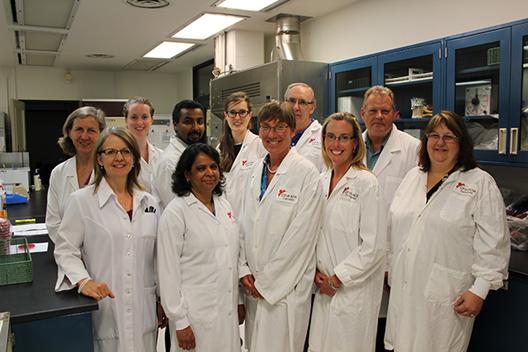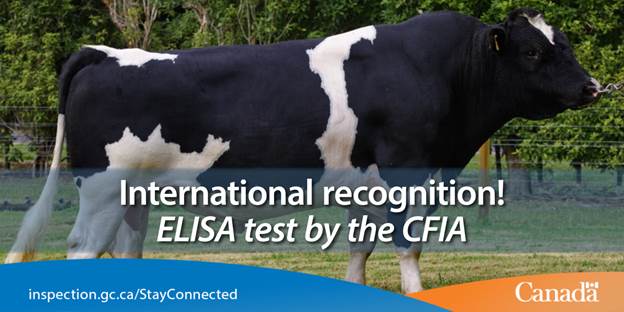By: Jeff Froggett
The Canadian Food Inspection Agency’s (CFIA) work is essential for a safe and accessible food supply. People may think of the CFIA as “food inspectors,” but the Agency’s role is much more than that. The CFIA doesn’t just use science; the Agency also develops new science every day through research discovery and implementation in order to minimize risks to the country’s plant and animal resources.
Sometimes this means testing cattle semen to make sure it is healthy. And sometimes it takes a microscopic discovery to yield enormous results.
Dr. Brian Brooks, Dr. John Devenish and their team at the CFIA’s Ottawa Animal Health Laboratories, located in the CFIA’s Ottawa Laboratory (Fallowfield), developed a more efficient test procedure to detect a rarely found organism – a subspecies of the Campylobacter fetus (CF) group, which causes an illness called bovine genital campylobacteriosis, or BGC.
BGC can cause infertility, early embryonic mortality and abortion in cattle. Canada is a multi-million dollar exporter of high-quality cattle semen and embryos, so having a test that quickly and accurately identifies BGC is important to Canada’s trade and economy.
Drs. Brooks and Devenish hypothesized that an enzyme-linked immunosorbent assay (ELISA) test format – using monoclonal antibodies specific to the CF group of organisms – could vastly improve turnaround times over the regular culture-based testing. That’s the test that the CFIA developed.
The enhanced ELISA test allows CF to be detected more readily by seeing a simple colour change in a test reaction, but only if CF is present in an animal sample.

Members of the Ottawa Laboratory (Fallowfield) Animal Health Microbiology Lab – Front row, from left to right: Cheryl Lutze-Wallace, Gloria Berlie-Surujballi, Cathie Elmgren, Jenni Widdison, Donna Milnes. Back row, left to right: Teresa Burke, Amanda Laverdiere, Mohamed Elmufti, Émilie Falardeau, Brian Brooks, John Devenish
Despite the fact that the cause of BGC, C. fetus ssp. venerealis (CFV), rarely appears in Canada, this country is not considered free from CFV. There must be continual testing at Canadian artificial insemination centres for the presence of CFV to prove to international markets that Canada is free of the pathogen. And, if detected, any finding must be reported each year to the World Organisation for Animal Health (OIE).
Given how rare BGC is in Canada, CFIA scientists found it difficult to validate their ELISA-based methodology to an international standard. With the very low prevalence of BGC infectivity in Canada, there just weren't enough positive samples available for the team to work with. This slowed down the project and made the task of validation more difficult.
The solution? Collaboration.
CFIA scientists reached out to the Veterinary Laboratory Association in Great Britain, where BGC infection is more common. Methods and materials were exchanged. Regular lines of communication were set up, but done in such a way that the final results were shared only after the testing was completed from each collaborator. This prevented bias in result analysis and maintained scientific rigour.
In the end, it took 12 years to validate the specialized CFIA ELISA test to international recognition, as follows:
- 2005 -- The new ELISA-based procedure was adopted for use within the CFIA. However, more CFV isolations were required to provide necessary statistical proof at an international level.
- 2008 – A rare opportunity presented itself when 114 bulls from the United States were moved to two artificial insemination centres in western Canada. The initial isolation of CFV from two animals in that group led to suspicions of a wider infection. All 114 animals were tested, using both the ELISA and traditional culture method, confirming the presence of CFV infection in 35 of the bulls. This provided the data to complete the validation. An application was made to the OIE.
- 2012 – The CFIA formally received a letter from the OIE accepting the test for placement in the next revised chapter of BGC in the Manual of Diagnostic Tests and Vaccines for Terrestrial Animals, enhancing the CFIA's global reputation.
Never one to rest on its laurels, the CFIA’s Ottawa Animal Health Laboratories team continues to develop, make improvements to and validate other test methods.

Canada is a multi-million dollar exporter of high-quality cattle semen and embryos. Having a quick and accurate cattle semen test is important to Canada’s trade and economy.
